Human Resource Planning Process Report - Bridford Furniture Company
VerifiedAdded on 2021/04/24
|5
|839
|61
Report
AI Summary
This report delves into the crucial aspects of human resource planning, focusing on forecasting labor demand and analyzing labor supply within an organization, specifically referencing the Bridford Furniture Company. It explores the importance of strategic workforce planning in aligning staffing needs with business objectives, highlighting the significance of both quantitative and qualitative approaches in demand forecasting. The report emphasizes the need for a balanced approach to labor supply, considering internal and external sources of talent, and stresses the importance of effective recruitment strategies. It also covers the evaluation of human resource planning, recommending considerations such as job design, remuneration, career development, rewards, and flexible work options to maximize productivity. The conclusion underscores the imperative of workforce planning in achieving strategic business goals, urging for the implementation of a plan to maximize productivity.
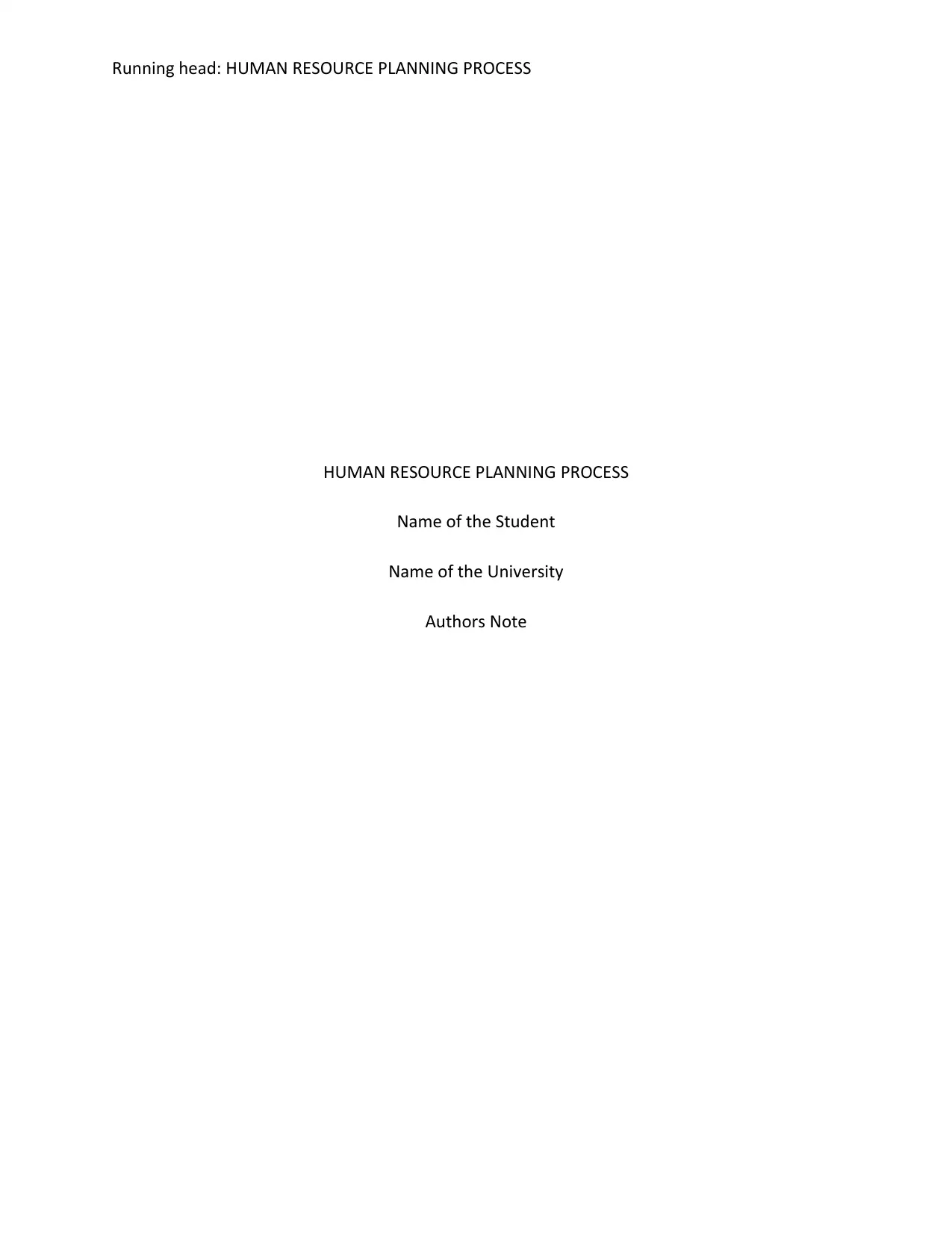
Running head: HUMAN RESOURCE PLANNING PROCESS
HUMAN RESOURCE PLANNING PROCESS
Name of the Student
Name of the University
Authors Note
HUMAN RESOURCE PLANNING PROCESS
Name of the Student
Name of the University
Authors Note
Paraphrase This Document
Need a fresh take? Get an instant paraphrase of this document with our AI Paraphraser
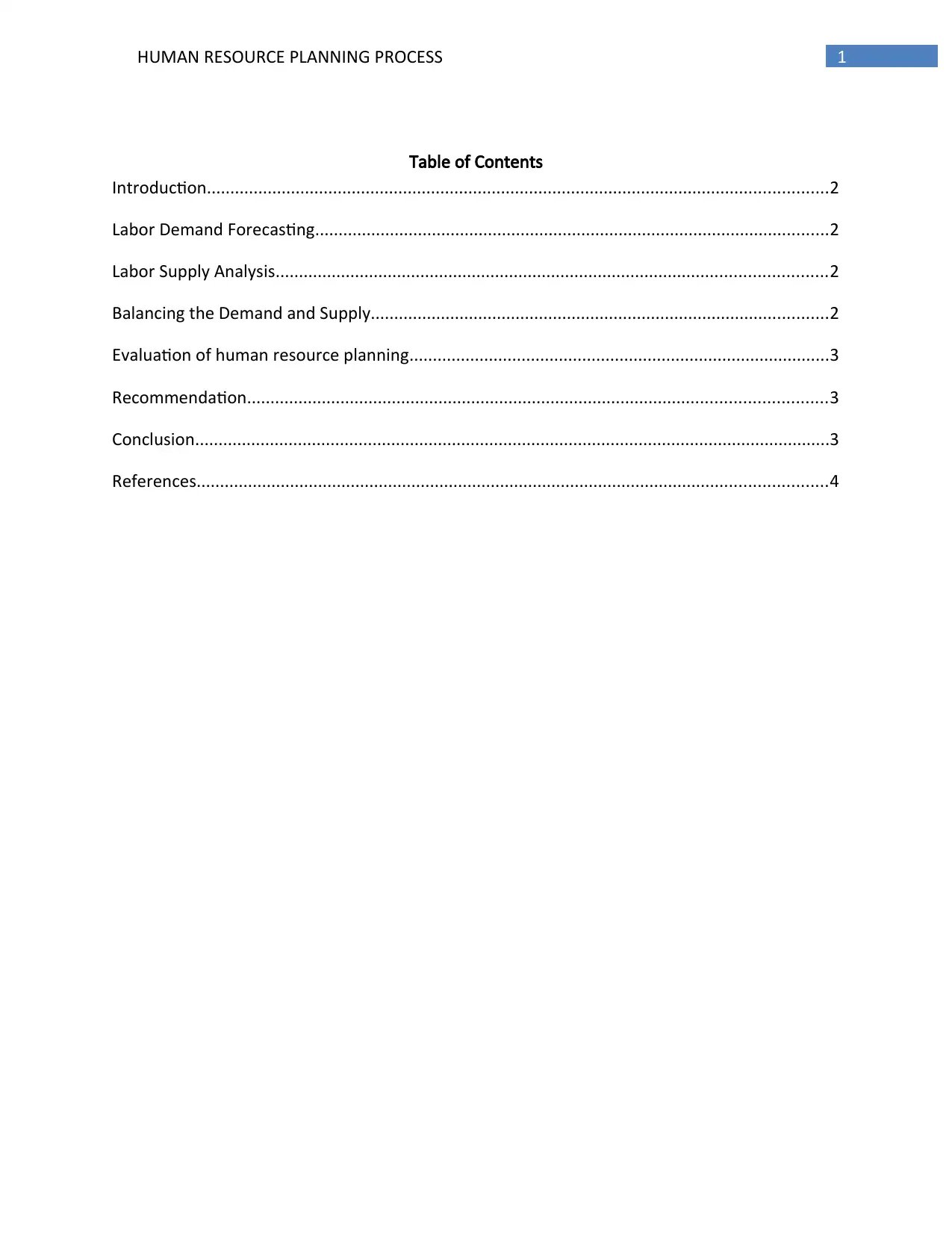
1HUMAN RESOURCE PLANNING PROCESS
Table of Contents
Introduction.....................................................................................................................................2
Labor Demand Forecasting..............................................................................................................2
Labor Supply Analysis......................................................................................................................2
Balancing the Demand and Supply..................................................................................................2
Evaluation of human resource planning..........................................................................................3
Recommendation............................................................................................................................3
Conclusion........................................................................................................................................3
References.......................................................................................................................................4
Table of Contents
Introduction.....................................................................................................................................2
Labor Demand Forecasting..............................................................................................................2
Labor Supply Analysis......................................................................................................................2
Balancing the Demand and Supply..................................................................................................2
Evaluation of human resource planning..........................................................................................3
Recommendation............................................................................................................................3
Conclusion........................................................................................................................................3
References.......................................................................................................................................4
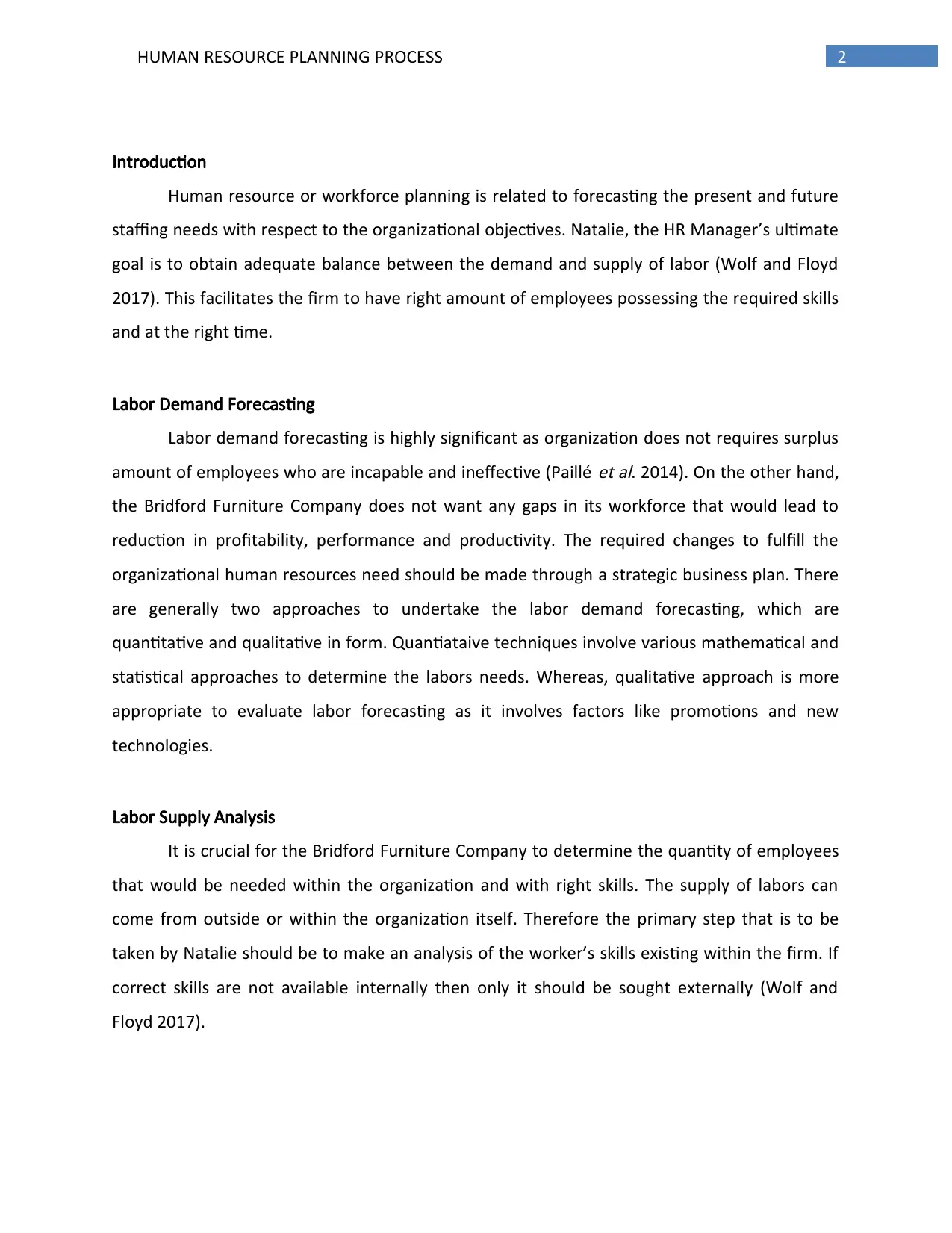
2HUMAN RESOURCE PLANNING PROCESS
Introduction
Human resource or workforce planning is related to forecasting the present and future
staffing needs with respect to the organizational objectives. Natalie, the HR Manager’s ultimate
goal is to obtain adequate balance between the demand and supply of labor (Wolf and Floyd
2017). This facilitates the firm to have right amount of employees possessing the required skills
and at the right time.
Labor Demand Forecasting
Labor demand forecasting is highly significant as organization does not requires surplus
amount of employees who are incapable and ineffective (Paillé
et al. 2014). On the other hand,
the Bridford Furniture Company does not want any gaps in its workforce that would lead to
reduction in profitability, performance and productivity. The required changes to fulfill the
organizational human resources need should be made through a strategic business plan. There
are generally two approaches to undertake the labor demand forecasting, which are
quantitative and qualitative in form. Quantiataive techniques involve various mathematical and
statistical approaches to determine the labors needs. Whereas, qualitative approach is more
appropriate to evaluate labor forecasting as it involves factors like promotions and new
technologies.
Labor Supply Analysis
It is crucial for the Bridford Furniture Company to determine the quantity of employees
that would be needed within the organization and with right skills. The supply of labors can
come from outside or within the organization itself. Therefore the primary step that is to be
taken by Natalie should be to make an analysis of the worker’s skills existing within the firm. If
correct skills are not available internally then only it should be sought externally (Wolf and
Floyd 2017).
Introduction
Human resource or workforce planning is related to forecasting the present and future
staffing needs with respect to the organizational objectives. Natalie, the HR Manager’s ultimate
goal is to obtain adequate balance between the demand and supply of labor (Wolf and Floyd
2017). This facilitates the firm to have right amount of employees possessing the required skills
and at the right time.
Labor Demand Forecasting
Labor demand forecasting is highly significant as organization does not requires surplus
amount of employees who are incapable and ineffective (Paillé
et al. 2014). On the other hand,
the Bridford Furniture Company does not want any gaps in its workforce that would lead to
reduction in profitability, performance and productivity. The required changes to fulfill the
organizational human resources need should be made through a strategic business plan. There
are generally two approaches to undertake the labor demand forecasting, which are
quantitative and qualitative in form. Quantiataive techniques involve various mathematical and
statistical approaches to determine the labors needs. Whereas, qualitative approach is more
appropriate to evaluate labor forecasting as it involves factors like promotions and new
technologies.
Labor Supply Analysis
It is crucial for the Bridford Furniture Company to determine the quantity of employees
that would be needed within the organization and with right skills. The supply of labors can
come from outside or within the organization itself. Therefore the primary step that is to be
taken by Natalie should be to make an analysis of the worker’s skills existing within the firm. If
correct skills are not available internally then only it should be sought externally (Wolf and
Floyd 2017).
⊘ This is a preview!⊘
Do you want full access?
Subscribe today to unlock all pages.

Trusted by 1+ million students worldwide
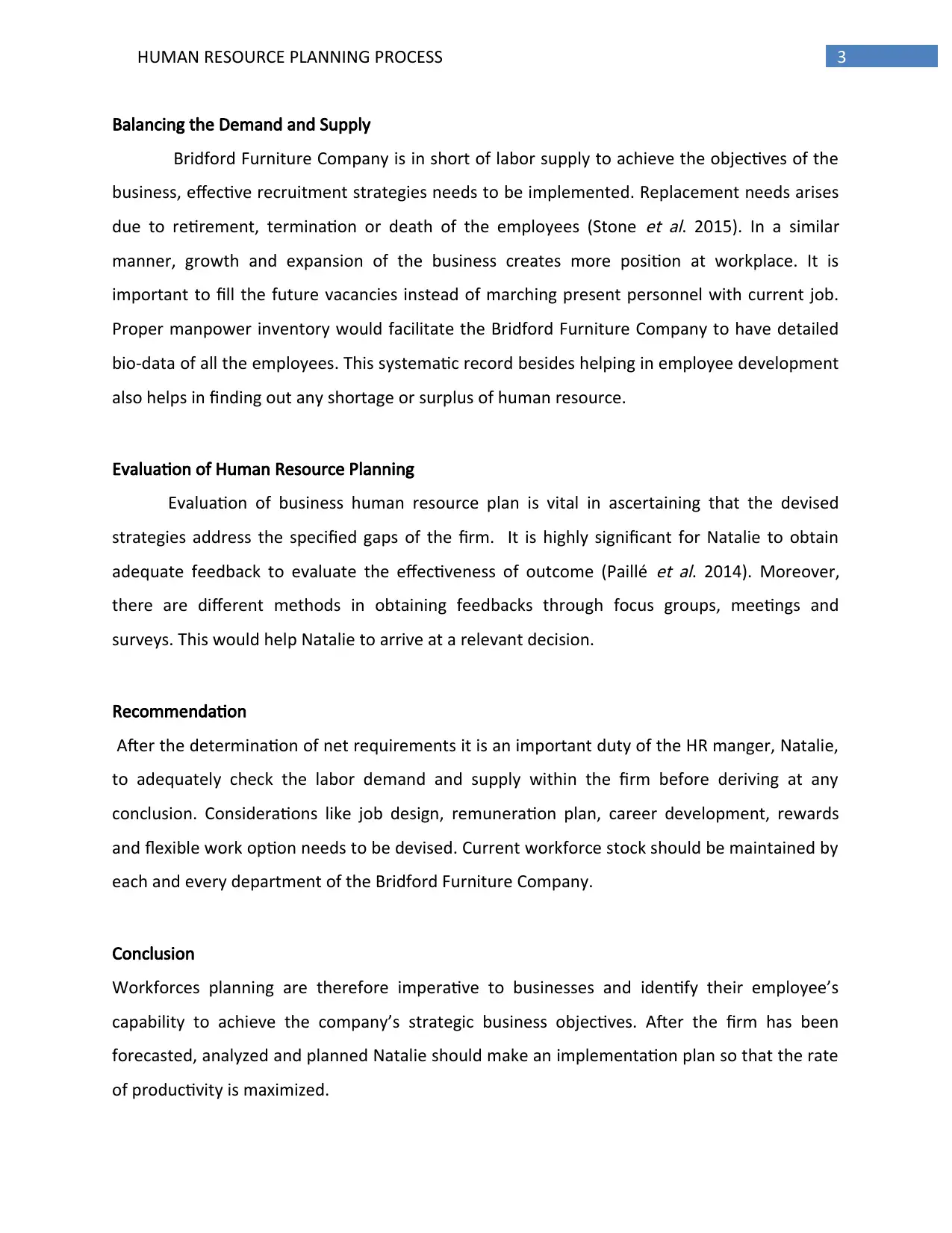
3HUMAN RESOURCE PLANNING PROCESS
Balancing the Demand and Supply
Bridford Furniture Company is in short of labor supply to achieve the objectives of the
business, effective recruitment strategies needs to be implemented. Replacement needs arises
due to retirement, termination or death of the employees (Stone
et al. 2015). In a similar
manner, growth and expansion of the business creates more position at workplace. It is
important to fill the future vacancies instead of marching present personnel with current job.
Proper manpower inventory would facilitate the Bridford Furniture Company to have detailed
bio-data of all the employees. This systematic record besides helping in employee development
also helps in finding out any shortage or surplus of human resource.
Evaluation of Human Resource Planning
Evaluation of business human resource plan is vital in ascertaining that the devised
strategies address the specified gaps of the firm. It is highly significant for Natalie to obtain
adequate feedback to evaluate the effectiveness of outcome (Paillé
et al. 2014). Moreover,
there are different methods in obtaining feedbacks through focus groups, meetings and
surveys. This would help Natalie to arrive at a relevant decision.
Recommendation
After the determination of net requirements it is an important duty of the HR manger, Natalie,
to adequately check the labor demand and supply within the firm before deriving at any
conclusion. Considerations like job design, remuneration plan, career development, rewards
and flexible work option needs to be devised. Current workforce stock should be maintained by
each and every department of the Bridford Furniture Company.
Conclusion
Workforces planning are therefore imperative to businesses and identify their employee’s
capability to achieve the company’s strategic business objectives. After the firm has been
forecasted, analyzed and planned Natalie should make an implementation plan so that the rate
of productivity is maximized.
Balancing the Demand and Supply
Bridford Furniture Company is in short of labor supply to achieve the objectives of the
business, effective recruitment strategies needs to be implemented. Replacement needs arises
due to retirement, termination or death of the employees (Stone
et al. 2015). In a similar
manner, growth and expansion of the business creates more position at workplace. It is
important to fill the future vacancies instead of marching present personnel with current job.
Proper manpower inventory would facilitate the Bridford Furniture Company to have detailed
bio-data of all the employees. This systematic record besides helping in employee development
also helps in finding out any shortage or surplus of human resource.
Evaluation of Human Resource Planning
Evaluation of business human resource plan is vital in ascertaining that the devised
strategies address the specified gaps of the firm. It is highly significant for Natalie to obtain
adequate feedback to evaluate the effectiveness of outcome (Paillé
et al. 2014). Moreover,
there are different methods in obtaining feedbacks through focus groups, meetings and
surveys. This would help Natalie to arrive at a relevant decision.
Recommendation
After the determination of net requirements it is an important duty of the HR manger, Natalie,
to adequately check the labor demand and supply within the firm before deriving at any
conclusion. Considerations like job design, remuneration plan, career development, rewards
and flexible work option needs to be devised. Current workforce stock should be maintained by
each and every department of the Bridford Furniture Company.
Conclusion
Workforces planning are therefore imperative to businesses and identify their employee’s
capability to achieve the company’s strategic business objectives. After the firm has been
forecasted, analyzed and planned Natalie should make an implementation plan so that the rate
of productivity is maximized.
Paraphrase This Document
Need a fresh take? Get an instant paraphrase of this document with our AI Paraphraser
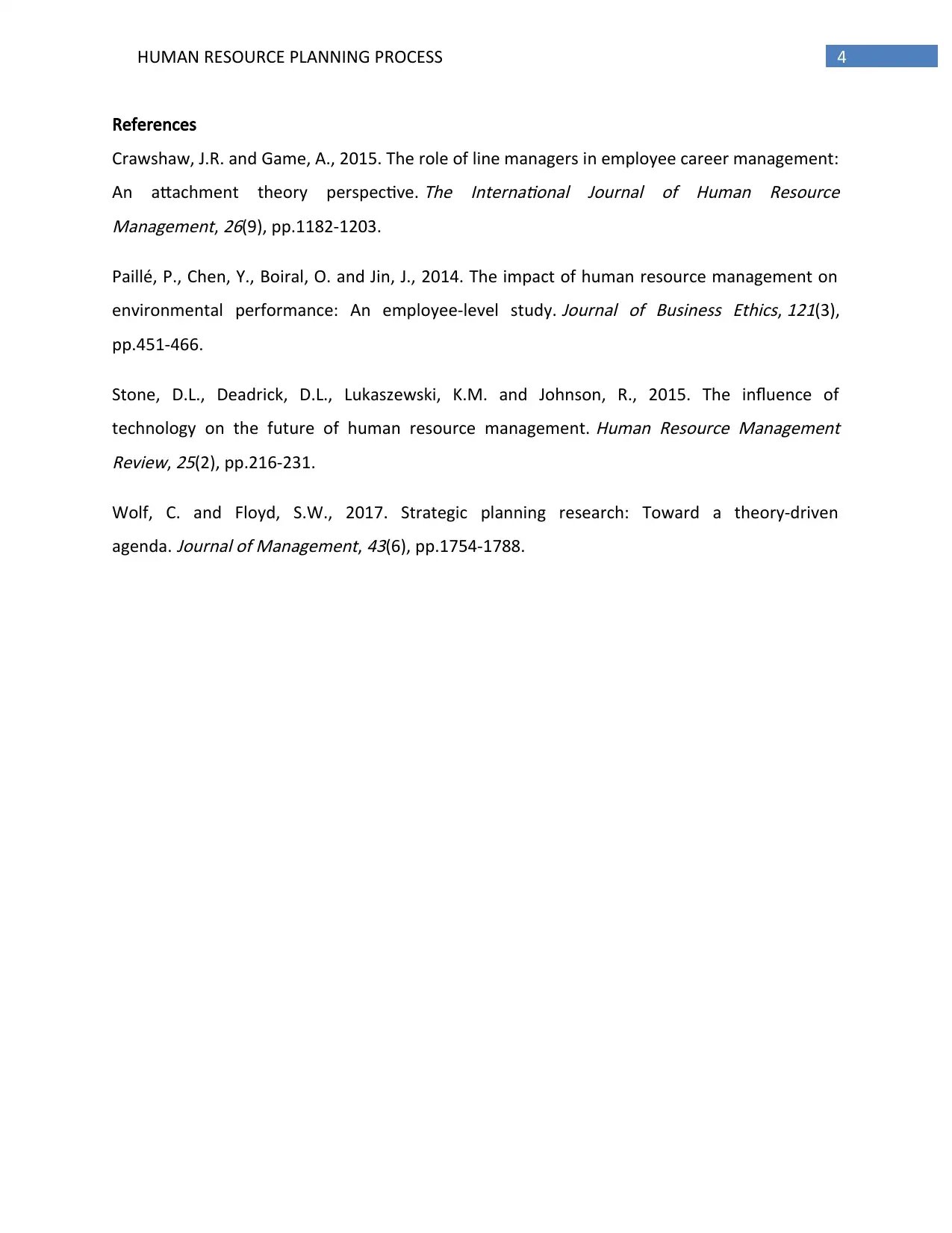
4HUMAN RESOURCE PLANNING PROCESS
References
Crawshaw, J.R. and Game, A., 2015. The role of line managers in employee career management:
An attachment theory perspective.
The International Journal of Human Resource
Management,
26(9), pp.1182-1203.
Paillé, P., Chen, Y., Boiral, O. and Jin, J., 2014. The impact of human resource management on
environmental performance: An employee-level study.
Journal of Business Ethics,
121(3),
pp.451-466.
Stone, D.L., Deadrick, D.L., Lukaszewski, K.M. and Johnson, R., 2015. The influence of
technology on the future of human resource management.
Human Resource Management
Review,
25(2), pp.216-231.
Wolf, C. and Floyd, S.W., 2017. Strategic planning research: Toward a theory-driven
agenda.
Journal of Management,
43(6), pp.1754-1788.
References
Crawshaw, J.R. and Game, A., 2015. The role of line managers in employee career management:
An attachment theory perspective.
The International Journal of Human Resource
Management,
26(9), pp.1182-1203.
Paillé, P., Chen, Y., Boiral, O. and Jin, J., 2014. The impact of human resource management on
environmental performance: An employee-level study.
Journal of Business Ethics,
121(3),
pp.451-466.
Stone, D.L., Deadrick, D.L., Lukaszewski, K.M. and Johnson, R., 2015. The influence of
technology on the future of human resource management.
Human Resource Management
Review,
25(2), pp.216-231.
Wolf, C. and Floyd, S.W., 2017. Strategic planning research: Toward a theory-driven
agenda.
Journal of Management,
43(6), pp.1754-1788.
1 out of 5
Related Documents
Your All-in-One AI-Powered Toolkit for Academic Success.
+13062052269
info@desklib.com
Available 24*7 on WhatsApp / Email
![[object Object]](/_next/static/media/star-bottom.7253800d.svg)
Unlock your academic potential
Copyright © 2020–2025 A2Z Services. All Rights Reserved. Developed and managed by ZUCOL.




